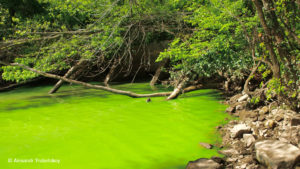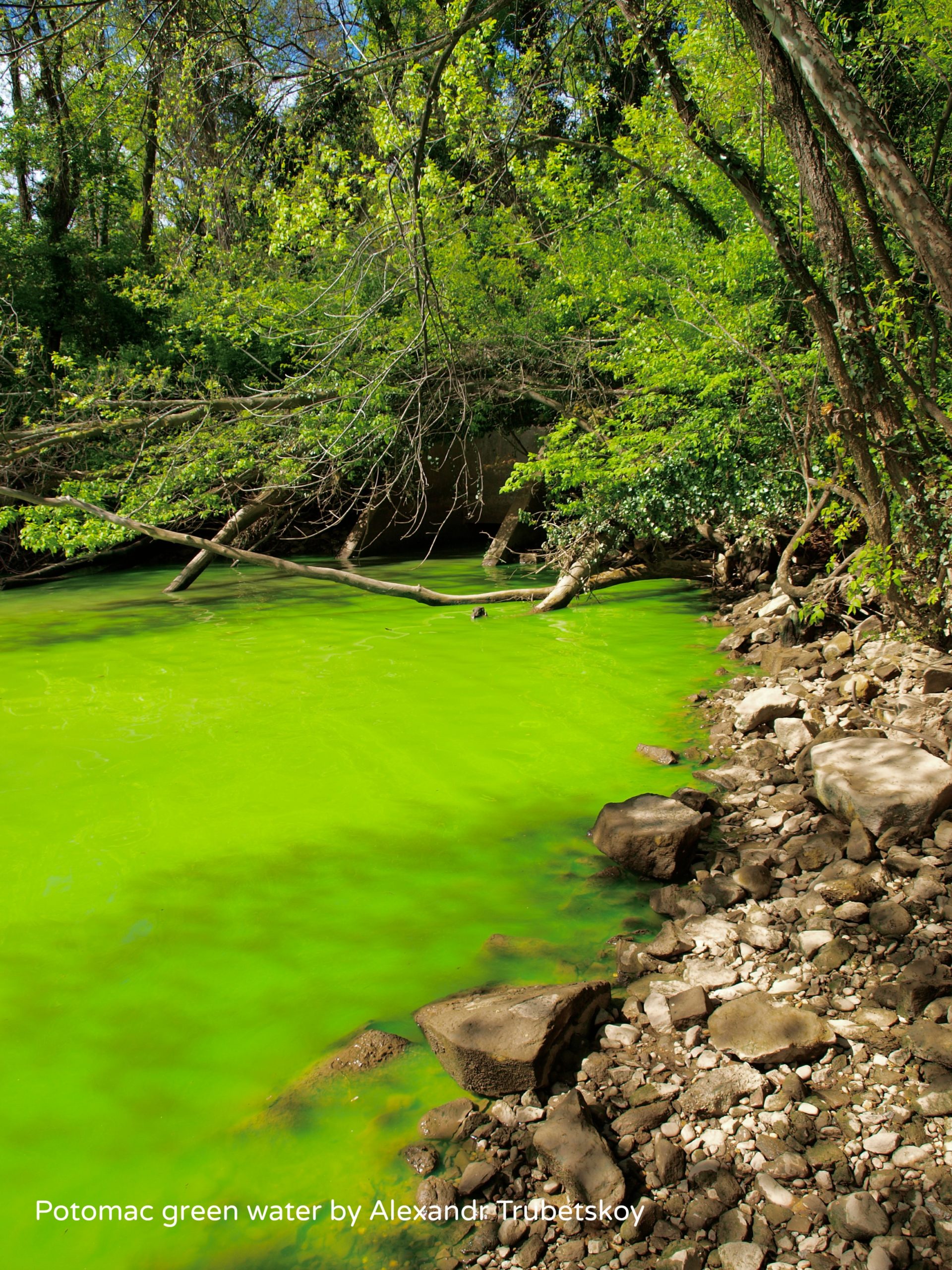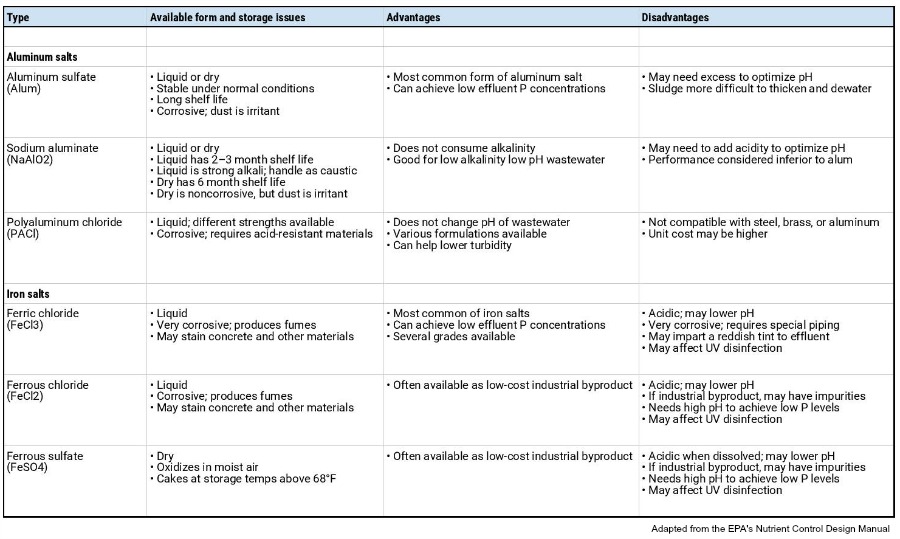
In Part 1 on this two-part article on wastewater lagoon phosphorus, Wastewater Lagoon Phosphorus: The Crackdown Is Coming, we outlined its sources and the reasons regulating bodies are beginning to add phosphorus effluent limits to permits.
Part 2 will present an overview of methods of phosphorus removal from wastewater lagoons.
Pathways of Wastewater Lagoon Phosphorus Removal
Phosphorus is removed from wastewater through either biological or chemical methods. While some phosphorus is removed naturally through regular lagoon biological treatment, it is difficult to meet any restrictive effluent standard with natural processes alone. Three ways phosphorus can leave a wastewater lagoon without intervention are:
- Through uptake by Phosphorus Accumulating Organisms (PAOs) like bacteria and algae.
- Through primary sedimentation, as inorganic phosphorus complexes sink to the bottom of the lagoon. As much as 15 percent of phosphorus is removed as settleable solids.
- Out with the effluent.
Regular lagoon treatment, especially with longer retention times, will remove some phosphorus, but not enough to meet effluent standards. Phosphorus removal, like ammonia removal, is temperature sensitive: According to Nutrient Removal in a Cold-Region Wastewater Stabilization Pond: Importance of Ammonia Volatilization, Journal of Environmental Engineering (April 2006), nearly 50 percent of influent phosphorus was lost from the water column during the summer-fall treatment period, but only about 35 percent was removed during the winter-spring period. Effluent can be stored through the winter and discharged when nutrient levels are the lowest to take advantage of nutrient removal that occurs during the warmer temperatures. This the most cost-effective method if sufficient lagoon capacity is available, although it will likely not remove enough phosphorus to meet the lower effluent limits that regulating bodies will be demanding in the future.
In order to meet very low phosphorus effluent levels of less than 1 mg/L or even lower, additional treatment is necessary.
Chemical Precipitation of Lagoon Phosphorus
In its Wastewater Phosphorus Control and Reduction Initiative, the Minnesota Environmental Science and Review Board (MESERB) states: “Chemical precipitation is the only feasible process for phosphorus removal for lagoon systems.” (Enhanced biological phosphorus removal [EBPR] is based on a suspended-growth activated sludge process.)
Unlike nitrogen, phosphorus does not have a gaseous form, so the only way it is removed is through sedimentation or precipitation—conversion to a solid that either settles in the sludge blanket or is removed through filtration. Soluble wastewater phosphorus can be coagulated with the addition of a metal salt like aluminum sulfate (alum); an iron salt like ferric chloride; or lime. Lime is now rarely used, due to the difficulty of handling and storing it, as well as its propensity to create sludge. According to the EPA’s Nutrient Control Design Manual, lime sludge can reach up to 0.5 percent of the volume of wastewater treated, the most of any chemical removal process.
The following chart, adapted from the EPA’s Nutrient Control Design Manual, highlights the pros and cons of the most popular metal salts used for the precipitation of phosphorus in wastewater.
Application Points of Metal Salts
The next issue is where to add the metal salts: in the primary cell, or in the polishing cell? A number of studies have demonstrated that chemical precipitation is more effective later in the process. In Field Study of Nutrient Control in a Multicell Lagoon, authors William T. Engel and Thomas T. Schwing concluded: “Alum addition to the third cell of a three-cell system produced lower total and soluble phosphorus concentrations in the final effluent [81–85% reduction] than alum addition in the first cell of a system [60–75% reduction].”
Lagoon systems with controlled discharge may choose to batch feed chemicals into the primary cell and use a motorboat for mixing, which is straightforward and economical. However, the changes in pH can inhibit BOD removal and nitrification, and the additional sludge created will be retained, potentially reducing treatment capacity and releasing trapped nutrients into the water column.
Lagoon systems with continuous discharge should consider continuous dosing of chemicals to treat phosphorus as a last step before discharge.
PhosBox™ Lagoon Phosphorus Removal
 Triplepoint has considered all the available science in developing its PhosBox lagoon phosphorus removal process, to optimize phosphorus removal while controlling costs.
Triplepoint has considered all the available science in developing its PhosBox lagoon phosphorus removal process, to optimize phosphorus removal while controlling costs.
PhosBox is installed as a final step before the discharge point to maximize the precipitation of phosphorus without interfering with lagoon treatment. Sensors monitor phosphorus levels and automatically dose the precise amount of metal salts needed for coagulation, mixing them in the influent chamber. The cloth disk filtration system captures the coagulated phosphorus and removes it from the effluent stream to a storage lagoon; the clean water is discharged.
Automated backwash cycles keep the filter media clean; sensors alert you when the low-cost filter media need to be replaced, which can be accomplished in minutes without downtime.
PhosBox allows lagoons to be upgraded to meet low phosphorus effluent limits—as low as 0.07 mg/L—on an existing footprint with minimal capital expense. Because the coagulant addition and backwash cycles are automated, it’s easy to operate and maintain.
For more information about PhosBox lagoon phosphorus removal, download the brochure.


